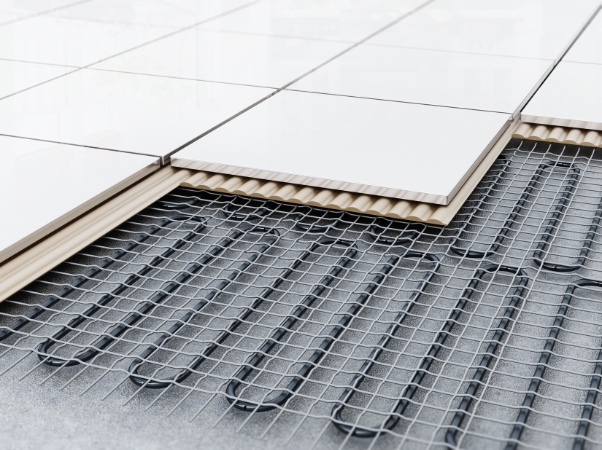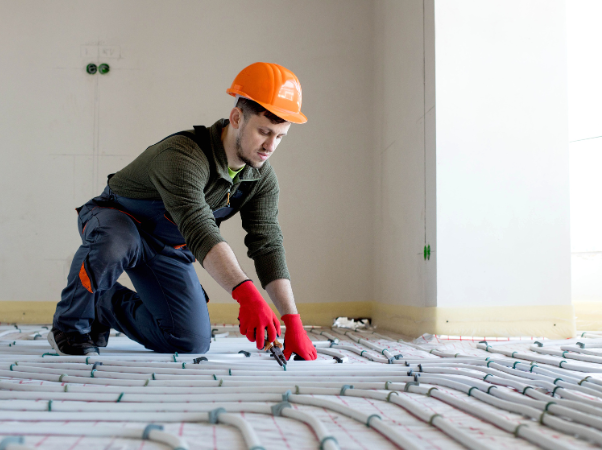Underfloor Heating Homeowner Guide
What Is Underfloor Heating?
Underfloor heating is a heating source used to heat your floor and provide a comfortable level of warmth to the room. A form of central heating, underfloor heating works using a system of pipes or wires laid under your floor's surface.

Is Underfloor Heating Good for My Home?
Underfloor heating works well in homes as it uses both radiant heat and convection heat, thus eliminating cold spots. This ensures a more even temperature throughout the room. Better still, it's a more energy-efficient solution when compared to traditional radiator systems.
For further information and guidance on underfloor heating, take a look at our underfloor heating buying guide.
What Types of Underfloor Heating Systems Are Available?
Delivering a low-maintenance heat source, underfloor heating is available as an electric or water system. Both choices will be more suitable depending on your home's needs.
An electric underfloor heating system is a popular choice among many homeowners for smaller rooms and homes. Due to its ease of installation, it’s often considered easier for retrofits. It’s also favoured for its inexpensive outlay, its minimal effect on floor height, and its ability to offer a selection of wattage output thus allowing more control when in use. Electric UFH is often favoured when upgrading bathrooms, ensuites or kitchens and is easy to install but can be more expensive to run.
Electric underfloor heating systems
A popular choice among many homeowners for smaller rooms and homes. Due to its ease of installation, it’s often considered easier for retrofits. It’s also favoured for its inexpensive outlay, its minimal effect on floor height, and its ability to offer a selection of wattage output thus allowing more control when in use. Electric UFH is often favoured when upgrading bathrooms, ensuites or kitchens and is easy to install but can be more expensive to run.
How does Electric Underfloor Heating Work?
An electric underfloor heating system consists of mats or foil that have a heating wire attached. Controlled by the thermostat, when the heating system is turned on, this wire heats up, providing an even spread of radiant heat to the floor's surface.

Water underfloor heating systems
Considered more suitable for those larger homes and rooms. And it's an ideal choice when used in multiple rooms at different temperatures. This choice is often favoured for new builds and when fully refurbishing the home. Cost-effective to run when compared to electric heating, water underfloor heating systems can also be controlled remotely.
How Does Water Underfloor Heating Work?
A water underfloor heating system consists of a large piping system laid under the floor to maximise even heat distribution. When this heating system is turned on and controlled by the thermostat, the water circulating through the pipes is heated. With a pump mixture unit fitted between the underfloor heating system and the heat source, the floor's surface is heated to the correct temperature.

Is Underfloor Heating Right For You?
Though underfloor heating is a heating solution that is suitable for nearly everyone to enjoy in their homes there are a few aspects to consider carefully before making your final decision.
How much underfloor heating will your room size need?
An important consideration with underfloor heating is the room size you’re looking to install it in. Electric underfloor heating is widely chosen for smaller areas of the home, in particular those spaces such as bathrooms and kitchens due to potential higher running costs here. Whereas water underfloor heating systems are considered to be better for larger rooms, and when installed in several different rooms of the home.
Can underfloor heating replace radiators?
Though it can be possible in some homes to use underfloor heating as your primary heating source, some areas may need a little extra heating boost just to ensure complete comfort. Once again, this factor will depend on the size of the room you’re looking to heat, its insulation, design, and current heating sources.
If your room is well-insulated then UFH should be capable of providing the full heating demand to your home. Yet, for those rooms that need just that little extra help, smaller radiators or heated towel rails may be required to boost the heat.
Is underfloor heating better than radiators?
Some people are simply not a fan of seeing bulky radiators taking up space around the home and consider replacing them with underfloor heating. Many also find radiators aren't entirely safe options for young children, they only work to heat certain areas of the room, and their reliance on air circulated solely via convection heating can aggravate many allergy sufferers. Overall, underfloor heating is considered to give a more comfortable, even heat while freeing up valuable wall space and being more efficient to run.
What type of flooring do you already have?
Underfloor heating works well with most flooring types including laminate, ceramic and stone tiles, vinyl, linoleum, and many carpet choices. However, solid wood is not advisable as it can shrink and expand by being dried out with the high heat.
Does underfloor heating work with carpet?
Though most carpeted areas can still benefit from underfloor heating, it’s advisable that both your carpet choice and underlay offer no more than a 2.5 tog in total. This is to allow the desired temperature to penetrate through the material.
How long does underfloor heating take to install?
If you’re looking for a quick installation process and little disruption, then an electric underfloor heating system will be your best choice. The ideal solution for retrofits, electric systems have minimal effect on existing floor heights. Though most electric underfloor heating systems can be fitted as a DIY project, a reputable installer will be able to install electric underfloor heating in less than one day.
Water underflooring heating systems understandably require a lengthier installation process, taking anywhere from one to as many as five days. This is primarily to do with it being a more complex system, especially in the process required of pulling up the floor to accommodate it. Though it can be a DIY job, it will require some basic experience.
How do you control underfloor heating?
Both electric and wet underfloor heating can be controlled via a thermostat. Electric thermostats allow you to control your room temperature from a central location, adjusting the heat to keep your room warm and comfortable. If you have underfloor heating through multiple rooms then it’s best to have them individually ‘zoned’ with separate stats controlling each area.
Immersion heater thermostats can be used for both water and electric underfloor heating systems. With a larger temperature sensor, they can help maintain the desired temperature by controlling the power output and the water being heated.
Such smart controls can help you get the most energy-efficient and comfortable temperatures throughout the day depending on the area and conditions, ultimately running at a lower temperature than radiators in the process.
How Much Does Underfloor Heating Cost?
The complete cost of underfloor heating will vary depending on several factors, including:
- The type of underfloor heating systems chosen - water or electric
- The size of the room/s you're intending to install it in
- The age of your building - whether a new build or a retrofit project
- How Much is Underfloor Heating?
The EE team at City Plumbing offers electric underfloor heating mats from as little as £104 for 1.5m2 to £400 for 12.0m2. Our water underfloor heating kits range from £480 for 15m2 and up to £4000 for 180m2. But, these prices will vary greatly considering how many rooms you wish to install underfloor heating in and the current floor construction.
- How Much Does Underfloor Heating Cost To Install in the UK?
Added to that price though will be the labour costs if you're having your underfloor heating fitted by a professional.
Overall, the Energy Solution Experts Greenmatch suggest expecting to pay anything from £2300 to £4500 for electric underfloor heating and £5500 to £11,000 for water underfloor heating. This is inclusive of buying the system itself and having it fitted professionally.
Is Underfloor Heating Expensive to Run?
The cost of running underfloor heating varies, but when used in combination with smart controls can work effectively at helping you save both money and energy.
This is because underfloor heating provides a warm spread of heat, leaving no more cold spots. So, you're not tempted to turn up the heating when certain areas of a room are colder than others.
Underfloor heating also runs at a lower temperature than radiators. Radiators work to temperatures of 75 to 85 ° when heating up, whereas an underfloor heating system works at 45 to 55 ° to heat up fully.
Should You Turn Off Underfloor Heating in the Summer?
When the outside temperature is warm, it’s advisable to turn underfloor heating off, especially if there’s no need for any heating sources to remain on in the home. This is especially so with the increasingly hot summers the UK now experiences.
How Long Does Underfloor Heating Take To Warm Up?
Depending on the floor space, the floor type, and the heating system installed, underfloor heating will need some time to warm up before it reaches the desired temperature. For an electric underfloor heating system, you can usually expect full operating temperature in minutes. Yet, for water-based underfloor heating, it can take anything from two to three hours to reach its full operating temperature.
Should Underfloor Heating Be on All the Time During Winter?
It’s advisable to keep your underfloor heating on at a low consistent temperature throughout the day during winter. All you need to do is to adjust the temperature to account for the activity during the day. If no one is home during the day, setting the thermostat to a low temperature will keep an even and consistent temperature and ensure when you return home and raise the temperature, it reaches the desired temperature faster.
Overnight, underfloor heating can once again be kept at a very low temperature to provide residual heat while still keeping energy bills low.
Better still, when used with a smart thermostat, you can further make savings by regulating your temperature to suit after the installation process.
How Long Does Underfloor Heating Last?
The great thing about underfloor heating is that a good reputable system can last up to as long as 50 years. When you compare that to a radiator's average lifespan of around 12 years, underfloor heating is certainly a worthwhile investment.
Finally, for those homeowners keen to create the most energy-efficient home, underfloor heating can be the best place to start. Underfloor heating systems work perfectly when paired with low-carbon solutions, like air source heat pumps. This is because both heating solutions are the most efficient at producing low water temperatures.




